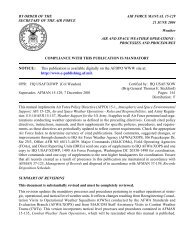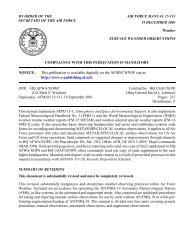Joint Metoc Handboo - IHMC Ontology and Policy Management
Joint Metoc Handboo - IHMC Ontology and Policy Management
Joint Metoc Handboo - IHMC Ontology and Policy Management
Create successful ePaper yourself
Turn your PDF publications into a flip-book with our unique Google optimized e-Paper software.
7-Navy<br />
initiatives such as the <strong>Joint</strong> Maritime Comm<strong>and</strong> Information System (JMCIS) <strong>and</strong><br />
<strong>Joint</strong> Maritime Communications Strategy (JMCOMS), is st<strong>and</strong>ardizing its C4I<br />
applications <strong>and</strong> services within the Defense Information Infrastructure (DII)<br />
Common Operating Environment (COE). JMCIS is the maritime Comm<strong>and</strong> <strong>and</strong><br />
Control (C2) program that supports U.S. Navy <strong>and</strong> Coast Guard operational units.<br />
JMCOMS supports the transfer of C2 information in a manner transparent to the<br />
user.<br />
The Navy has identified seven information functional categories that encompass a<br />
number of operational needs: (1) plan operations, (2) manage readiness, (3)<br />
manage the battlespace, (4) fuse intelligence/sensor information, (5) correlate<br />
information, (6) comm<strong>and</strong> forces, <strong>and</strong> (7) support C4I system operations. In order<br />
to satisfy these functional needs the Navy has established a number of system<br />
requirements for JMCOMS. Although not listed here, these requirements are<br />
allocated to the various applications, the DII COE <strong>and</strong> communications. GCCS-M<br />
uses plug-<strong>and</strong>-play software to define functionality <strong>and</strong> to provide access to<br />
common services. Plug-<strong>and</strong>-play components enable the user, according to his/her<br />
privileges, to access the following:<br />
> Core Systems Services > Status of Forces<br />
> Warfare Applications > Cryptologic Support<br />
> Undersea Warfare Systems > Messaging<br />
> Briefing Support > LAN/WAN<br />
> Logistics Support > Tactical/Track <strong>Management</strong><br />
> Training > NATO Support<br />
> USMC Support > Imagery<br />
> <strong>Joint</strong> Intelligence > Employment scheduling<br />
> Communications interface > Remote Access<br />
> METOC > Systems <strong>and</strong> Resource <strong>Management</strong><br />
> Utilities/Tools<br />
- GCCS-M. The Navy has transitioned to the Global Comm<strong>and</strong> <strong>and</strong> Control System<br />
– Maritime. The GCCS-M software has a METOC segment known as NITES II.<br />
The NITES II METOC segment enables the GCCS-M user to ingest gridded field,<br />
observational, <strong>and</strong> imagery data. Gridded fields (available via JMV 3.0 <strong>and</strong><br />
FLENUMMETOCCEN) are displayed as contours (st<strong>and</strong>ard <strong>and</strong> color filled) <strong>and</strong><br />
wind barbs. A threshold feature enables GCCS-M users to view areas of potential<br />
hazards (high winds <strong>and</strong> seas), plus imagery <strong>and</strong> METOC status boards (stop light<br />
displays). The user can display bathythermograph, radiosonde, <strong>and</strong> surface<br />
observations, as well as atmospheric refractivity <strong>and</strong> acoustic conditions.<br />
- CTAPS/JDISS. Comm<strong>and</strong> ships <strong>and</strong> selected aircraft carriers are capable of<br />
supporting the CJTF <strong>and</strong> functional component comm<strong>and</strong>ers. These ships routinely<br />
host the Contingency Tactical Air Control System Automated Planning System<br />
(CTAPS). Existing GCCS workstations can easily be configured for joint staffs by<br />
7-5




